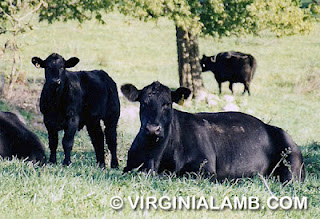We are very proud of our customers and their devoted interest in where their food comes from. It does not surprise us that many have asked us to raise and offer veal along with our other meat selections.
 Veal has a rather dark cloud hanging over it, as veal operations have come under more and more scrutiny in recent years. Believe it or not, that gallon of milk you purchased this week has quite a bit to do with the US veal industry. The commercial dairy farmer has one interest when it comes to cattle – females. Each female calf born grows up to be a productive member of tomorrow’s milking herd. The problem is that statistically 50% of the calves born are bull (male) calves and they are of little or no value to the dairy farmer. Ah, here is where the infamous veal industry comes in, they buy up all the bull calves to raise on milk replacer (powdered milk) to harvest as veal. Little did any of us realize the horrific conditions many of these animals were subjected to in the past.
Veal has a rather dark cloud hanging over it, as veal operations have come under more and more scrutiny in recent years. Believe it or not, that gallon of milk you purchased this week has quite a bit to do with the US veal industry. The commercial dairy farmer has one interest when it comes to cattle – females. Each female calf born grows up to be a productive member of tomorrow’s milking herd. The problem is that statistically 50% of the calves born are bull (male) calves and they are of little or no value to the dairy farmer. Ah, here is where the infamous veal industry comes in, they buy up all the bull calves to raise on milk replacer (powdered milk) to harvest as veal. Little did any of us realize the horrific conditions many of these animals were subjected to in the past.
In stark contrast, take our farm. We have over 180 acres where on any given day you will see cattle, sheep, goats, and chickens enjoying the sunshine and grazing green pastures (and occasionally Grandma’s flower gardens – but that’s another story). Our animals are happy with free access to feed, clean water, shelter, and companionship. So the question is how to incorporate veal into our operation while staying true to our priority for happy, naturally and humanely raised livestock.
Our family owns and manages a cow/calf beef operation — meaning that we keep a herd of 40-50 mother cows on the farm that calve every spring. Those calves stay with the cows until weaning time when they weigh approximately 400-500 lbs. We then sell them to another farmer who continues to feed them, finishing them to 1100-1200 lbs for harvesting. We keep back a small group of calves to feed out, but simply do not have the pasture nor the market to finish 40+ calves a year.
But wait, when you really think about it, veal could be a very natural part of our operation. So we decided to harvest one of the weanling calves to give it a try. Unlike the pale milk-only fed veal you find in the grocery story you will see that ours has a nice rose color. This is from a combination of sunshine, exercise, mother’s milk, and pasture. And because our veal is from beef breeds (instead of dairy breeds) you can expect it to be flavorful, tender, and meatier. Our veal calves are not artificially raised but left on the cow to be raised the way nature intended and with no undue stress.
We can’t wait to see what you think! Here is a great recipe to get you started.
Veal Marsala
- 8 veal cutlets or chops
coarse salt
freshly ground black pepper
2 to 3 tablespoons unsalted butter
2 to 4 tablespoons olive oil
1 large shallot, finely chopped
2 to 4 garlic cloves, minced
2 ounces assorted mushrooms, sliced
1/2 cup sweet Marsala wine
3/4 cup chicken stock
Leaves from 1 fresh rosemary sprig
Season veal with salt and pepper. Melt 1 tablespoon of butter and 1 tablespoon of oil in a heavy large skillet over medium-high heat.
Add 4 veal cutlets and cook until golden brown, about 1 1/2 minutes per side. Transfer the veal to a plate. Add another tablespoon of butter and oil, if necessary.
Repeat with the remaining 4 cutlets. Set cutlets aside.
Add 1 tablespoon of oil to the skillet. Add shallot and garlic. Saute until soft, about 30 seconds. Add a tablespoon of the olive oil, if necessary. Add the mushrooms and saute until tender and the juices evaporate, about 3 minutes. Add the Marsala wine. Simmer until the wine reduces by half, about 2 minutes.
Add the chicken stock and the rosemary leaves. Simmer until reduced by half.
Return the veal to the skillet. Pour in all of the pan juices. Cook just until heated through, turning to coat, about 1 minute. Stir the remaining 1 tablespoon of butter into the sauce.
Season the sauce with salt and pepper, to taste.
We can only source Rose Veal here in Ireland and it is just impossible to get folks to try it! Such an excellent meat and I love your explanation of how it differs from milk fed veal. I found you through Jungle-frog blog ;0)
Sad to hear folks won’t try it. Our customers love it! But we are very fortunate to have such a strong following first from our lamb, then our other meats. Thank you for stopping by. Love that it is becoming such a small world!